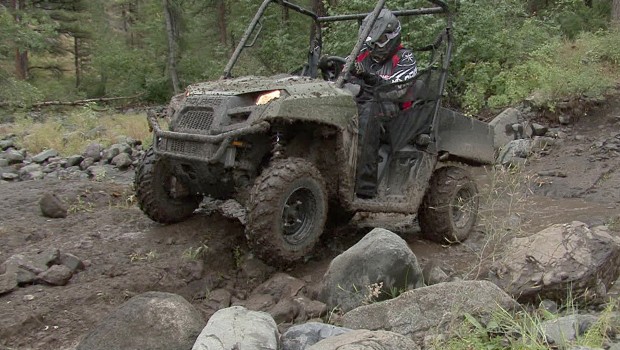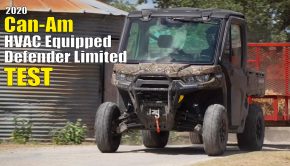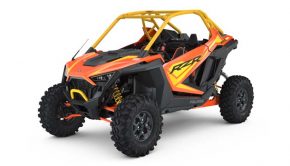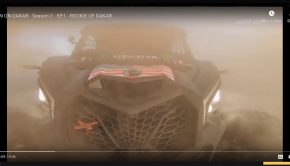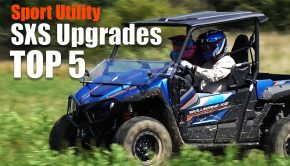2013 Polaris 800 EFI Mid-Size Test: with VIDEO
This compact utility UTV is a sleeper out on the trail.
 Whether it’s trucks, TVs, or UTVs, most of us all want the biggest and the baddest. When it comes to utility UTVs, one of the biggest and baddest machines for 2013 is the Polaris Ranger XP900. Its towing, storage, and ability to be customized for working, hunting, or playing, make it one of the most versatile and comfortable machines with which you can hit the trail. There is so much to like about the XP900 that it makes the vehicle hard to look past––well, until you realize that you need $12,999 to purchase the base model.
Whether it’s trucks, TVs, or UTVs, most of us all want the biggest and the baddest. When it comes to utility UTVs, one of the biggest and baddest machines for 2013 is the Polaris Ranger XP900. Its towing, storage, and ability to be customized for working, hunting, or playing, make it one of the most versatile and comfortable machines with which you can hit the trail. There is so much to like about the XP900 that it makes the vehicle hard to look past––well, until you realize that you need $12,999 to purchase the base model.
If you can’t afford the nearly $13,000 buy in the Ranger XP900, you may have to settle for second best. Actually, it may still be the best; it just depends on how you look at it. While the XP900 rules Polaris’ full size Ranger lineup, the midsize Ranger 500 has been surpassed as the king of Polaris’ midsize working class. Ranger’s new middleweight champion, the 800 EFI, is a capable workhorse, with the power-to-weight ratio to let it rip out on the trail. For $2,500 less than the new XP900, it’s also a machine more of us can afford to own, so we felt it was a 2013 we couldn’t afford bypass.
The Technical Stuff
The midsize Ranger 800 EFI uses a very similar chassis to the Ranger 400 and 500. We had tested the 400 in the past and felt its solid handling and adequate power made it a fun, small bore workhorse. The 800 features the same 72in. wheelbase as the other middleweights, but is 1.5 inches wider at 58in.
Like the other midsize Rangers, the 800 features 8 inches of suspension travel up front, 9 out back, with 10 inches of ground clearance. The front suspension features MacPherson Struts. The IRS consists of dual a-arms and shocks, with a sway bar helping keep the back end riding level
The Ranger 400 weighs 1050 pounds and is powered by an engine claimed to produce 29hp. The Ranger 800 weighs just 35 pounds more at 1085 pounds. Its 760cc inline twin cylinder engine is claimed to put out 50hp.
 The transmission features high and low ranges, in addition to neutral, reverse, and park. There is the usual two-wheel/all-wheel- drive system Polaris uses, which can either operate in full time two-wheel drive, or in all-wheel-drive, engaging the front wheels only when the system detects the rear wheels beginning to slip. It provides lighter steering most of the time, and more traction when needed.
The transmission features high and low ranges, in addition to neutral, reverse, and park. There is the usual two-wheel/all-wheel- drive system Polaris uses, which can either operate in full time two-wheel drive, or in all-wheel-drive, engaging the front wheels only when the system detects the rear wheels beginning to slip. It provides lighter steering most of the time, and more traction when needed.
Unfortunately, engine braking and Active Descent Control were left out, although low range and a little throttle will help control your speed on long downhills. Hydraulic disc brakes at all four corners provide stopping power, and contact with the ground is handled by 25in. tires mounted on basic stamped steel wheels.
The interior of the Ranger is a bit more utility than sport with its bench seat. The gear selector lever also looks a little utilitarian, which is acceptable for this machine. Tilt steering is nice, and the combo digital and analog instrument display is easy to read.
The Polaris Lock & Ride equipped bed can haul a 1,000-pound payload. The two-inch receiver can tow up to 1,250 pounds.
Ride Time
During a day of riding multiple machines, it was hard to explore all of the 800’s minute details; however, driving it back to back with the Ranger XP900, we got a good feel for how the middle-weight performed.

Weighing just 35 pounds more than the Ranger 400 while enjoying a 21 horsepower advantage, the Ranger 800 is a little ripper!
Weighing just 35 pounds more than the Ranger 400 while enjoying a 21 horsepower advantage, the Ranger 800 is a little ripper! We felt it was quicker out of the hole than the larger, beefier XP900. On the trail, the 800 is smooth and manageable while offering ample power for attacking hills and sliding out of turns. Crawling along, the engine and transmission remain responsive and manageable, which will aid the 800 when it comes to working, hunting, or exploring.
The lack of engine braking isn’t a big deal thanks to the brakes’ good power and feel. You could easily lock all four up in the slippery Montana mud.Negotiating through the wet terrain was simple. Leave it in two-wheel-drive if you want to slide out of turns; or flip it into all-wheel-drive and the front wheel will help pull you through turns, up hills, or any time the rear wheels start spinning and need some help.

Handling on the 800 is stable; there is a hint of body roll driving hard into turns, but nothing unsettling.
Handling on the 800 is stable; there is a hint of body roll driving hard into turns, but nothing unsettling. At moderate speeds and on side hills, the machine feels planted. Steering is pretty accurate, with just a hint of under-steer, which may aid a bit in the machine’s predictable feeling on smooth, high-speed trails.Ranger models seem to take a little more movement of the steering wheel to make the same turn as on some other models, but steering effort and bump feedback are both pretty light without the expense of EPS.
Suspension action is plush at both ends, with perhaps a slightly firmer feeling up front, traversing square edge hits. On fast gravel roads and rough wooded trails, the Ranger’s suspension keeps things predictable and smooth. It’s plush enough for all-day work and play, although it’s not quite as supple as the Ranger XP900, which seemingly lets you float over most trail clutter.

The suspension, light weight, and abundant horsepower allow you to have a little more fun than you might expect.
The suspension, light weight, and abundant horsepower allow you to have a little more fun than you might expect from a working/hunting focused machine. Just don’t get too carried away in the whoops. This is a Ranger, not a RZR.
Riding back to back with the XP900, we found the interior of the 800 notably less refined and a bit less comfortable.The 800’s seat isn’t as nicely padded, but the thing that stood out the most was a lack of extra legroom in the 800. The interior isn’t really objectionable; just don’t ride your buddy’s XP900 and you’ll probably be satisfied.
Conclusion
For getting work done, the pieces are all in play. The midsize 800 can be easily transported to wherever you are working, camping, or hunting since it fits in the bed of a full size pickup truck. When you get there, the extra performance of the 800’s engine will help you work or play even harder.
With a base price of $10,499, the Ranger 800 is $1000 less expensive than the base model Rhino 700, and $500 less than the base model Kawasaki Teryx750, or Arctic Cat Prowler 700; although, in ways, the Ranger doesn’t seem quite as modern and refined. The 800’s price lacks the wow factor that the 400 delivers, but it’s still a class leader when it comes to price. Getting what you pay for, the Ranger gives up a little attention to detail while bringing big bore UTV performance a little more affordable price.
Manufacturer: Polaris
Model: 2013 Ranger 800 MId-Size
Price: Starting at $10,499
2013 Polaris 800 EFI Mid-Size: Ratings
Summary: With a base price of $10,499, the Ranger 800 is $1000 less expensive than the base model Rhino 700, and $500 less than the base model Kawasaki Teryx750, or Arctic Cat Prowler 700; although, in ways, the Ranger doesn’t seem quite as modern and refined. The 800’s price lacks the wow factor that the 400 delivers, but it’s still a class leader when it comes to price. Getting what you pay for, the Ranger gives up a little attention to detail while bringing big bore UTV performance a little more affordable price.

